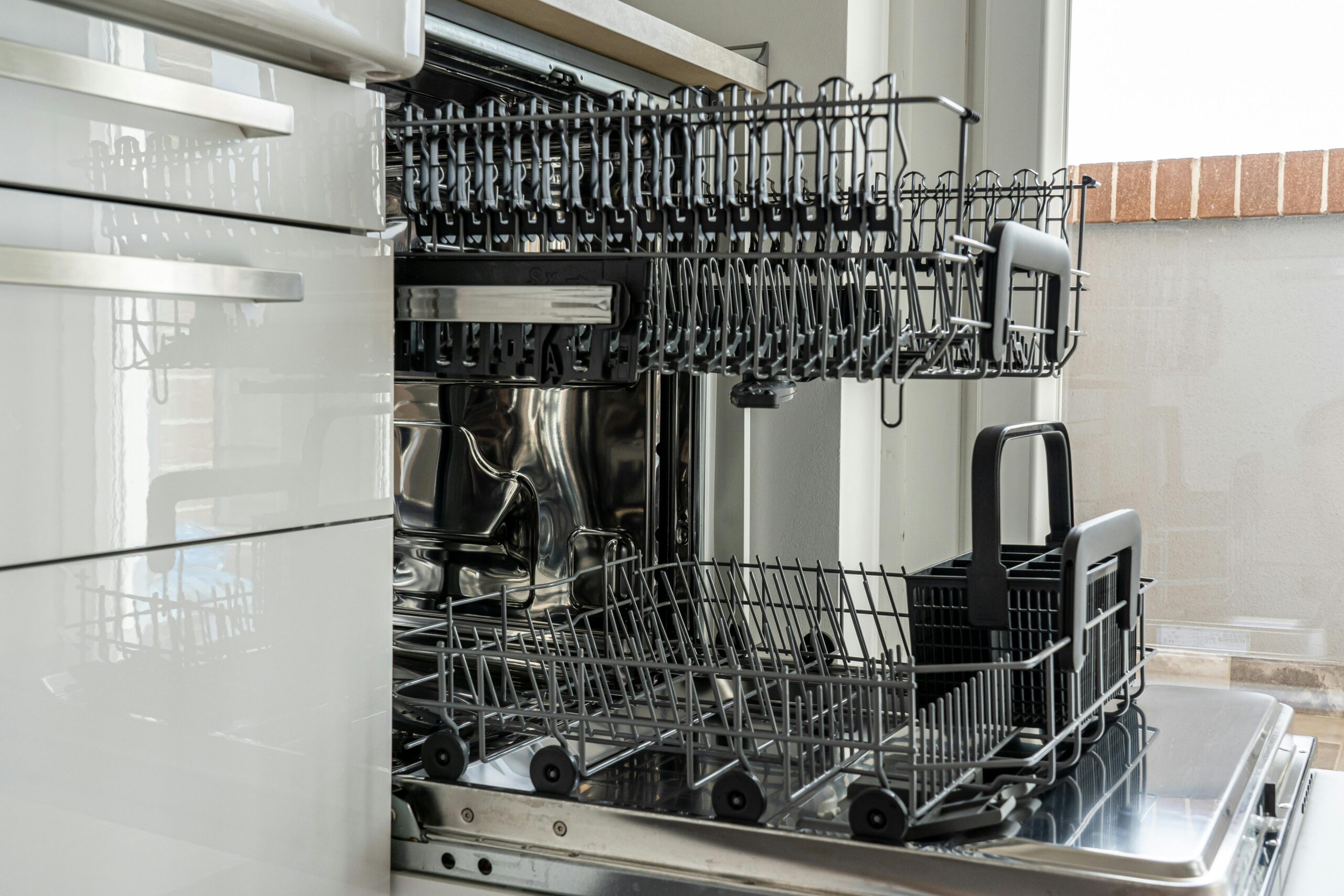Learn how to clean dishwasher effectively with our comprehensive guide. Discover daily, weekly, and monthly maintenance tips, natural cleaning methods, and solutions to common issues to keep your dishwasher running efficiently and odor-free.
Maintaining a clean dishwasher is essential for ensuring its efficiency and longevity. Over time, food particles, soap scum, and mineral deposits can build up, leading to unpleasant odors and reduced performance. This comprehensive guide will walk you through the steps to clean your dishwasher thoroughly, from daily maintenance to deep cleaning techniques.
Table of Contents
Maintaining a clean dishwasher is essential for ensuring its efficiency and longevity. Over time, food particles, soap scum, and mineral deposits can build up, leading to unpleasant odors and reduced performance. This comprehensive guide will walk you through the steps to clean dishwasher thoroughly, from daily maintenance to deep cleaning techniques.
Understanding Your Dishwasher
Components of a Dishwasher
Before diving into the cleaning process, it’s essential to understand the different parts of a dishwasher:
- Spray Arms: The spray arms of the dishwasher spray water and rotate which clean the dishes properly.
- Filter: Traps food particles to prevent them from redepositing on the dishes.
- Heating Element: Heats the water and dries the dishes.
- Detergent Dispenser: During washing dispense the detergent.
- Racks: Hold the dishes in place.
- Gasket: Prevent leaking water by sealing the door.
- Drain: Removes the dirty water from the dishwasher.
How a Dishwasher Works
A dishwasher operates through a series of cycles:
- Pre-wash: Rinses the dishes with water.
- Wash: Sprays hot water mixed with detergent.
- Rinse: Removes detergent residue.
- Dry: Uses hot air or residual heat to dry the dishes.
Understanding these components and cycles helps identify areas that need regular cleaning and maintenance.
Cleaning Methods: How to Clean Dishwasher
Daily Cleaning
Scraping Food Residues
To prevent food particles from clogging the filter and causing unpleasant odors, scrape off large food residues from the dishes before loading them into the dishwasher. This simple step reduces the load on the dishwasher and enhances its cleaning efficiency.
Wiping the Door and Gasket
The door and gasket can accumulate grime and soap scum over time. Use a damp cloth to wipe the interior surface of the door, focusing on the edges and corners. Pay special attention to the gasket, as it can harbor mold and mildew. A mixture of water and mild dish soap works well for this purpose.
Weekly Cleaning
Cleaning the Filter
The filter plays a crucial role in trapping food particles and preventing them from redepositing on the dishes. Most dishwashers have a removable filter located at the bottom of the tub. Follow these steps to clean it:
- Take out the Bottom Rack: Need to remove the bottom rack for accessing the filter.
- Remove the Filter: Consult your dishwasher’s manual for instructions on removing the filter.
- Rinse the Filter: Rinse the filter under running water to remove food particles.
- Scrub if Necessary: Use a soft brush or sponge to scrub off any stubborn residues.
- Reassemble: Put the filter back in place and return the bottom rack.
Inspecting the Spray Arms
The spray arms can get clogged with food particles or mineral deposits, reducing their effectiveness. To inspect and clean them:
- Remove the Spray Arms: Consult your dishwasher’s manual for instructions on removing the spray arms.
- Rinse and Scrub: Rinse the spray arms under running water and use a toothpick or small brush to clear any blocked holes.
- Reattach: Once cleaned, reattach the spray arms and ensure they can rotate freely.
Monthly Cleaning
Cleaning the Interior
Over time, the interior of the dishwasher can accumulate soap scum, grease, and grime. To clean it:
- Empty the Dishwasher: Ensure there are no dishes inside.
- Run a Hot water Cycle: After placing a dishwasher-safe cup filled with white vinegar on the top rack then run a hot water cleaning cycle. Vinegar helps dissolve grease and remove odors.
- Wipe the Interior: After the cycle, wipe down the interior walls, door, and gasket with a damp cloth.
Deodorizing the Dishwasher
To keep your dishwasher smelling fresh, sprinkle a cup of baking soda on the bottom of the dishwasher and run a short, hot water cycle. Baking soda neutralizes odors and leaves the interior smelling clean.
Deep Cleaning Techniques
Descaling the Dishwasher
Mineral deposits from hard water can build up inside the dishwasher, affecting its performance. To descale the dishwasher:
- Purchase a Descaling Agent: Look for a descaling agent specifically designed for dishwashers.
- Follow Instructions: Follow the manufacturer’s instructions for using the descaling agent. Typically, it involves running a cycle with the agent instead of detergent.
Cleaning the Drain
A clogged drain can lead to standing water at the bottom of the dishwasher. To clean the drain:
- Take out the Bottom Rack: Remove the bottom rack for accessing the drain area.
- Clear Debris: Check the drain for any debris and remove it.
- Use a Mixture of Baking Soda and Vinegar: Pour a mixture of baking soda and vinegar down the drain, followed by hot water to clear any clogs.
Inspecting and Cleaning the Spray Arms
As part of your deep cleaning routine, remove the spray arms, rinse them thoroughly, and clear any blocked holes. Ensure they are free of any debris that could impede their function.
Natural Cleaning Methods
Using Vinegar: How to Clean a Dishwasher with Vinegar
- Vinegar is a natural cleaning agent that effectively dissolves grease and mineral deposits. To use vinegar:
- Place a Cup of Vinegar: Put a dishwasher-safe cup filled with white vinegar on the top rack.
- Run a Hot Water Cycle: Run the dishwasher on a hot water cycle to clean and deodorize.
Using Baking Soda: How to Clean a Dishwasher with Baking Soda
Baking soda is excellent for neutralizing odors and providing a mild abrasive for cleaning. To use baking soda:
- Sprinkle Baking Soda: Sprinkle a cup of baking soda on the bottom of the dishwasher.
- Run a Short Cycle: Run a short, hot water cycle to clean and deodorize.
Using Lemon Juice: How to Clean a Dishwasher with Lemon Juice
- Lemon juice is a natural deodorizer and can help remove stains. To use lemon juice:
- Place Lemon Juice: Fill a dishwasher-safe cup with lemon juice and place it on the top rack.
- Run a Hot Water Cycle: Run the dishwasher on a hot water cycle for a fresh, clean smell.
Common Issues and Solutions
Addressing Cloudy Glassware
- Cloudy glassware can be caused by hard water deposits or detergent residue. To address this issue:
- Use a Rinse Aid: Add a rinse aid to your dishwasher to help prevent mineral deposits.
- Check Water Temperature: Ensure the water temperature is hot enough (at least 120°F) for effective cleaning.
- Use Vinegar: Run a cycle with vinegar to remove any mineral buildup.
Dealing with Persistent Odors
Persistent odors can be caused by trapped food particles or mold. To eliminate odors:
- Clean the Filter: Regularly clean the filter to remove trapped food particles.
- Use Baking Soda: Sprinkle baking soda on the bottom of the dishwasher and run a short, hot water cycle.
- Check the Drain: Ensure the drain is not clogged and is functioning properly.
Improving Dishwasher Performance
If your dishwasher is not cleaning effectively:
- Check the Spray Arms: Ensure the spray arms are not clogged and can rotate freely.
- Use the Right Detergent: Use a high-quality detergent designed for dishwashers.
- Avoid Overloading: Do not overload the dishwasher, as this can obstruct water flow and reduce cleaning efficiency.
Preventative Measures
Using the Right Detergent
Using the right detergent is crucial for maintaining your dishwasher’s performance. Look for detergents specifically designed for dishwashers and avoid using regular dish soap, which can create excess suds.
Loading the Dishwasher Properly
Proper loading ensures efficient cleaning:
- Do Not Overcrowd: Avoid overcrowding the dishwasher to ensure water and detergent reach all items.
- Face Dishes Inward: Load dishes with the dirty side facing the center of the dishwasher.
- Separate Utensils: Mix utensils in the utensil holder to prevent them from nesting together.
Running Hot Water Before Starting
Running hot water in the sink before starting the dishwasher ensures that the initial water entering the dishwasher is hot, improving cleaning performance.
Conclusion
Regular maintenance and cleaning dishwasher are essential for its efficiency and longevity. By following the steps outlined in this guide, you can keep your dishwasher in top condition, ensuring your dishes come out sparkling clean every time. Remember, a little effort in maintaining your dishwasher goes a long way in preventing costly repairs and replacements.
FAQs
1. How often should I clean dishwasher?
Perform daily and weekly maintenance tasks regularly. Deep clean dishwasher monthly or as needed.
2.Can I use bleach to clean dishwasher?
Avoid using bleach to clean dishwasher as it can damage the dishwasher’s interior and is harmful if mixed with other cleaning agents.
3.What causes a dishwasher to smell bad?
Food particles, grease, and soap scum can cause unpleasant odors. Regular cleaning dishwasher prevents this.
4.Is it necessary to clean a self-cleaning dishwasher?
Yes, even self-cleaning dishwashers benefit from regular maintenance and cleaning.
5.Can I use dish soap to clean dishwasher?
No, Avoid using soap and use dishwasher-specific cleaning products or natural solutions like vinegar and baking soda.



